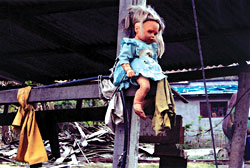 Wayne Amtzis' third exhibition in the Siddhartha Gallery juxtaposes harsh, colourless reality with the power of creation and fancy. His photographs present the paradox that demands we take responsibility for the world around us-considering the undignified, the nameless, the overworked and all those who, like mute animals, make life easier for us-and yet find a way out of its snares, snatching moments of liberation and relief.
Wayne Amtzis' third exhibition in the Siddhartha Gallery juxtaposes harsh, colourless reality with the power of creation and fancy. His photographs present the paradox that demands we take responsibility for the world around us-considering the undignified, the nameless, the overworked and all those who, like mute animals, make life easier for us-and yet find a way out of its snares, snatching moments of liberation and relief. The black and white Street Life exhibition is a direct projection of the callous indifference marking city life. In 'Sleeping Porters, Nag Pokhari' emaciated men use a cement block and a cart for beds, their skeleton for mattresses. These photos are a comment on what we, the privileged, don't want to witness, don't want to be a part of. A few photos are pictures of pictures. In 'Icons' Mahatma Gandhi, Marx, Ambedkar and Jesus stare at us. If they are a celebration of or a reminder of who we ought to be, what answers might we have for them?
Still Life casts a different aura. If a mood can be represented graphically, if imagination and expression can be manifested through the physical, then Amtzis' work which consists of found, almost stumbled upon, objects, is vividly eloquent. The photographs illustrate the artist's observant mind, his perception of the most trivial, his struggle and gain amidst waste and loss. Roadside scraps, backyard booty evoking forgotten times or a lost childhood seem to reveal a mood and meaning otherwise overlooked. The evocations of colour, the shaping power of aesthetics and the transformations of desire are all captured in these photos. A rusted bucket is presented as a gaudy base holding an equally bright rag. A tarnished iron stove retains its oxidized state as it becomes a reservoir of light and wealth.
Poetry is a recurring image in this poet-photographer's work. In Street Life, poems appear as commentary. In Still Life, typewritten, termite-eaten, worn to shreds, Amtzis' earlier poems weave themselves into the substance of the photos. Set as background, they complement shapes and objects and comment on them at the same time. In 'Graverobbers' a jawbone (teeth still intact) seems to have scavenged the pages and the leaves on which it is set. The experimentation in 'Exile' not only adds an embossed effect, but actually transforms verse into a level, floating, map of exile.
The echoing of image and theme is strong throughout these photos: prayer beads, the yinyang and the Kala Chakra are set beside everyday objects like taps, gloves and bowls, and astride aggrandising words whose meaning escapes us. One of the most disturbing pictures is 'Doll'. A lifesize doll in a pretty blue frock is strapped to a pole of what looks like a sawmill. She stares from two angry, sunken sockets, her hands spookily curled by her side. Standing before it can be hard. It accuses too directly.
Amtzis has more than just photos to offer. He has a worldview. A promise both of sensitivity and recklessness. As life, in the experience of it, should always be.
Still life/ Street life Photographs by Wayne Amtzis, till 3 May at Siddhartha Art Gallery, Baber Mahal Revisited


